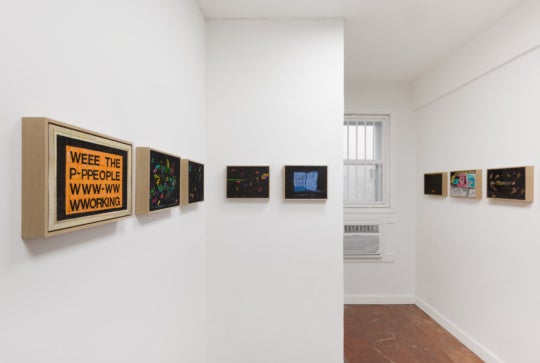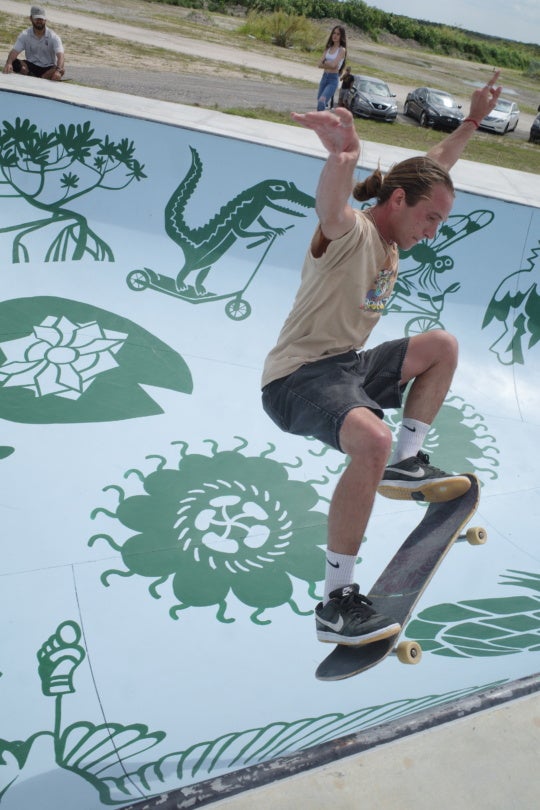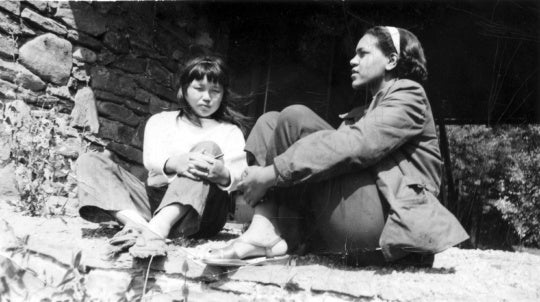
Tanz Farm’s goal throughout the series is to create a conversation, sociability and experience through performance. This was achieved during series two over the December 14-16 weekend. With three different dance performances choreographed by zoe/juniper, Sidra Bell and Staib Dance, Tanz Farm proved that this anthology of art was both diverse and collective simultaneously. Each performance for the winter series seemed to hold similar elements: relationships, dependability, community, and competition. Although portrayed in unique and different ways, the series, like any well-crafted anthology, belonged together.
(Read more about Tanz Farm’s origins and the partnership between gloATL and the Goat Farm Arts Center in our review of Series 1.)
The first of the night’s performances was zoe/juniper’s No one to witness and adjust, study #3: for forgetting. Inside the Goodson Yard at The Goat Farm the elaborate setting of the first piece not only took over the stage but also the seating area. A thick dirt floor off center in the rehabilitated factory with dancers already in position attracted the eye instantly. Although seemingly simple and bare minimal scenery, the plaster moldings of human limbs, faces and bodies laid on the dirt, hung from the rafters and sat on tables and near audience members chairs. A sheer white curtain separated the dirt stage into two sections. Unfortunately the elements that were most intriguing about the performance were the set and visual add-ons. Although the dancers themselves used the elements and at many moments held the energy and attention of the audience, there were also many other sections of the piece that were just overly distracting, in a good way, except for the fact that they took away from the performers themselves. The projections onto the sheer curtains and shadows mirrored the movements that were taking part on the stage but took the eye away from the real-time performance taking place. The mix use of the background and set design plus the performers brought the attention back to where it should be: not held on one element alone, but seeing it as a whole. The dancers, clad in nude mesh and painted on blue necks, with long braids that were wrapped and unwrapped from their necks switched from one side of the curtain to the other, allowing the audience to experience parts of the performance through a sort of veil. The movements were avian like, a theme that seemed to phase into the next performance. And the dirt and shifting of the curtain brought in nature in a less synthetic way than using fans.

The second section of the winter series was more back to the basics dance. No frills, no fuss, just a good floor and movement. Staibdance’s Crevasse was the most successful of the night. It did not need scenery or setting to be intriguing. The dancers themselves without strange costume or distracting elements fed the audience energy, emotion and shared a few of the societal images and nuances that the first performance started. The audience moved from the mesmerizing set elements of the first performance and left the natural appeal of the dirt and physically walked into another area of the Goodson Yard to experience what else was in store for the night ahead. Lined along the edge of the spring floor were twelve performers eager to take us into the next section. Once the dancers took the floor and worked in unison and shared powerful solos and duets, I was reenergized by the excitement of being able to see dance in a contemporary light, yet having it still just be dance. The second series took what the first one began, added to the relationship and human experience conversation starters and propelled the audience into what was about to come: a less clean and more actual take on what it means to live in a world that is not solely reclusive.
Although Sidra Bell’s Nudity took on the same less overly theatrical as Crevasse, it was a bit long winded. It could have been the cold, or the speaker in my ear but towards what I thought was the end, I kept thinking that each time the music began to fade into a more tolerable pitch that it was going to be time to clap and move on, this happened about five times until it was actually true. The elements of this performance were powerful and took what the last two performances shared and threw them into a fierce, competitive and harsh environment. But it was almost as if since the performance itself was set in such heavy ideals and left the audience to think of internal questions about their external lives that not only was it the longest performance of the series, but it also felt that way. The dancers were each dressed in black bikini bottoms and sheer black blouses, their hair was died the same color and done the same way, high, long pony tails. There was an androgynous feel to the costume as well as the performance itself. Power and strength was shared between both male and female dancers. Sex and nakedness was not the issue at hand, nudity in the sense of being bare and raw and stripped mentally through physical action and in society was what was most profound. It left me with the questions of what it means to be nude, what causes it and when brought to this state is it positive or negative?
Although there were certain portions of series two that weren’t as completely successful as others, the series as a whole completed what good art and what Tanz Farm was after: conversation. Each performance was able to be interpreted and taken in different ways, the elements could be debated and talked about for hours as well as the significance and meaning behind them. It was beautiful, hitting and memorable.
For more photos of this month’s Tanz Farm series, check this Flickr set by John Ramspott. The next section of the anthology, series three, will be running March 14-24 at Goodson Yard at the Goat Farm Arts Center.




